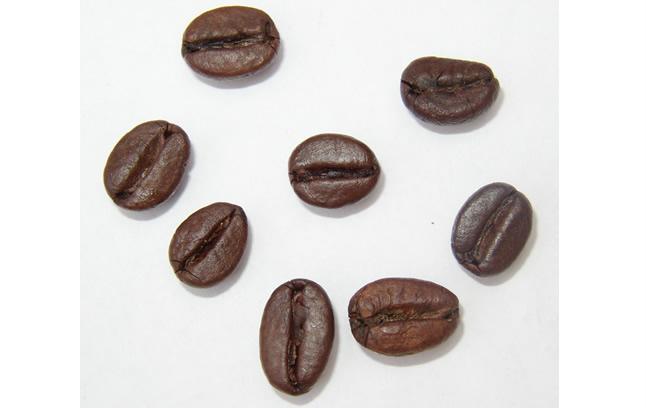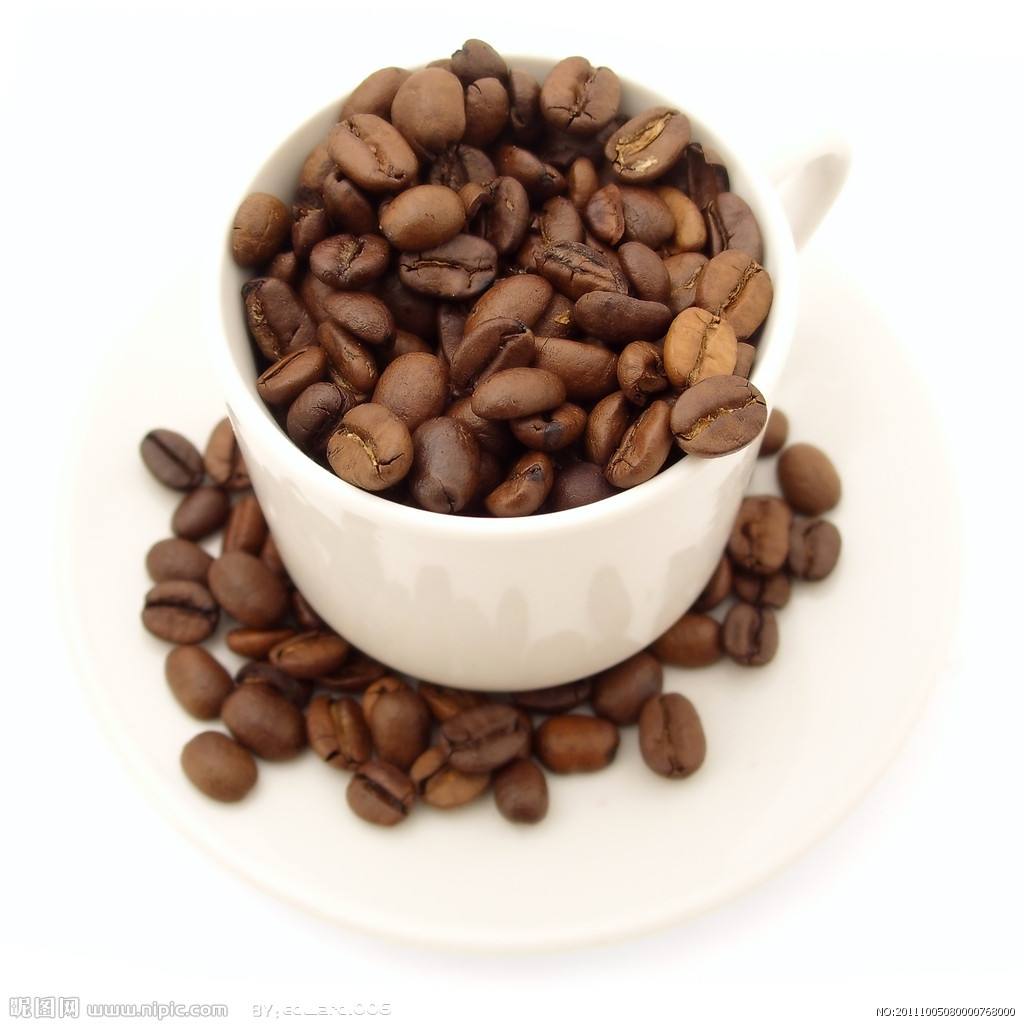Why is coffee healthy? chlorogenic acid is the most important nutrient in coffee.
Follow the caf é (Wechat official account vdailycom) and found that Beautiful Cafe opened a small shop of its own.
Among the 101 reasons why coffee is innocent, Professor Hu Dayi, a well-known health education expert and cardiovascular expert in China, and his partners found that coffee is a functional food rich in antioxidants. At present, there are more than 1500 kinds of substances that can be separated in coffee, of which 800 are beneficial nutrients and 700 are useless and harmless.
Chlorogenic acid (Chlorogenic acid), also known as caffeic acid tannic acid, is a phenolic acid composed of caffeic acid (Caffeic acid) and quinic acid (Quinic acid). Synonym caffeic acid tannic acid, chemical name 3-O-caffeoylquinic acid (3-O-caffeoylquinic acid) molecular formula: C16H18O9, molecular weight: 354.30, is a kind of benzene compound produced by shikimic acid pathway in the process of aerobic respiration. Chlorogenic acid is widely found in higher dicotyledons and ferns, mainly in Lonicera and Artemisia. The plants with high content are Eucommia ulmoides, honeysuckle, sunflower, succus, coffee, cacao and so on. In addition, chlorogenic acid is found in fruits (such as apples, pears), vegetables (such as potatoes, potatoes), soybeans, wheat, green tea and other daily food items.

Chlorogenic acid has extensive antibacterial activity, but it can be inactivated by protein in vivo. Similar to caffeic acid, oral or intraperitoneal injection can improve the central excitability of rats. It can increase the peristalsis of small intestine in rats and mice and the tension of uterus in rats. It has cholagogic effect and can increase the bile secretion of rats. One of the main antibacterial and antiviral pharmacological components of traditional Chinese medicine Flos Lonicerae is chlorogenic acid.
Which plants contain chlorogenic acid
Eucommia ulmoides Eucommia ulmoides Oliv. Leaves, honeysuckle, honeysuckle, honeysuckle or hairy style honeysuckle Lonicera dasytyla Rehd. Dried buds or newly blooming flowers, fruit of English Hawthorn of Rosaceae, cauliflower of Lycopersaceae, slope willow of disease-free family, Eurasian water keel rhizome of Polygonaceae, false Patch of Verbenaceae, cabbage stem and leaf of cruciferae, flat storage whole grass of Polygonaceae, whole plant of Rubiaceae, capsule of honeysuckle. Whole grass. The leaf of a sweet potato of the family Convolvulaceae. Seeds of small fruit coffee, medium fruit coffee, and large fruit coffee of Rubiaceae. Leaves and roots of burdock, a plant of the family Compositae.
Chemical and physical properties of chlorogenic acid
Chlorogenic acid is an ester formed by caffeic acid and quinic acid. There are three unstable parts in its molecular structure: ester bond, unsaturated double bond and polyphenol. Microherb studies have shown that in the process of extraction from plants, isomerization often occurs through hydrolysis and transfer of lactone groups. Because of the special structure of chlorogenic acid, it can be extracted from plants by using polar solvents such as ethanol, acetone and methanol, but because of its instability, chlorogenic acid can not be extracted at high temperature, strong light and heating for a long time. It is recommended to avoid light and seal cryopreservation during preservation. The test solution of chlorogenic acid is the most stable when it is stored in brown bottle and refrigerator (2 ℃).
Chlorogenic acid is that hemihydrate is needle-like crystal, 110 °becomes anhydrous compound, melting point is 208 °, solubility in 25 °water is 4%, and solubility in hot water is even greater. Chlorogenic acid is soluble in ethanol and acetone and slightly soluble in ethyl acetate. When coffee beans are roasted and the temperature in the oven exceeds 208 °, they begin to fission to hypochlorogenic acid, which is an extremely bitter substance and one of the main sources of bitterness in deep-roasted coffee.
According to the different binding sites and numbers of caffeoyl on quinic acid, there are theoretically 10 kinds of chlorogenic acid isomers composed of monocaffeoylquinic acid and dicaffeoylquinic acid. They are: 1-caffeoylquinic acid, 3-caffeoylquinic acid, 4-caffeoylquinic acid, 5-caffeoylquinic acid, 1, 1, 3-dicaffeoylquinic acid, 1-dicaffeoylquinic acid, 1 5-dicaffeoylquinic acid, 3-dicaffeoylquinic acid, 4-dicaffeoylquinic acid. But so far, the isomers of chlorogenic acid found in plants are as follows: chlorogenic acid (5-caffeoylquinic acid), cryptochlorogenic acid (Band510) (4-caffeoylquinic acid), neo-chlorogenic acid (3-caffeoylquinic acid), iso-chlorogenic acid A (3-dicaffeoylquinic acid), iso-chlorogenic acid B (3-dicaffeoylquinic acid), iso-chlorogenic acid C (4). 5-dicaffeoylquinic acid (5-dicaffeoylquinic acid), lycopene (1-dicaffeoylquinic acid).
Medical value and application of chlorogenic acid
Chlorogenic acid has a wide range of biological activities. Modern scientific research on the biological activity of chlorogenic acid has gone deep into many fields such as food, health care, medicine, daily chemical industry and so on. Chlorogenic acid is an important bioactive substance, which has the functions of antibacterial, antiviral, increasing white blood cells, protecting liver and gallbladder, anti-tumor, lowering blood pressure, lowering blood lipid, scavenging free radicals and stimulating central nervous system.
1. Antibacterial and antiviral
Eucommia chlorogenic acid has strong antibacterial and anti-inflammatory effect, aucubin and its polymer have obvious bacteriostatic effect, and aucubin has inhibitory effect on both Gram-negative and Gram-positive bacteria. Aucubin has bacteriostatic, diuretic effect, and can promote wound healing; aucubin pre-cultured with glucoside will also produce obvious antiviral effect, but it itself does not have antiviral function. The Institute of ageing Medical Science, Aichi Medical University, Japan, has confirmed that the alkaline substance extracted from Eucommia ulmoides has the function of anti-virus that destroys the human immune system, and this substance may be used to prevent and treat AIDS.
2. Antioxidation.
Chlorogenic acid is an effective phenolic antioxidant, which is stronger than caffeic acid, p-hydroxybenzoic acid, ferulic acid, eugenic acid, butyl hydroxyanisole (BHA) and tocopherol. The reason why chlorogenic acid has antioxidation is that it contains a certain amount of R-OH group, which can form hydrogen free radicals with antioxidant effect to eliminate the activity of hydroxyl radicals and superoxide anions and other free radicals, so as to protect tissue from oxidation damage.
3. Scavenging free radicals, anti-aging, anti-musculoskeletal aging
Chlorogenic acid and its derivatives have stronger free radical scavenging effects than ascorbic acid, caffeic acid and tocopherol (vitamin E). They can effectively scavenge DPPH free radicals, hydroxyl radicals and superoxide anion radicals, and inhibit the oxidation of low density lipoprotein. Chlorogenic acid plays an important role in effectively scavenging free radicals, maintaining the normal structure and function of cells, preventing and delaying the occurrence of tumor mutation and aging. Eucommia chlorogenic acid contains a special component that can promote the synthesis and decomposition of collagen in human skin, bone and muscle, which can promote metabolism and prevent decline. It can be used to prevent skeletal and muscle decline caused by space weightlessness. It is also found that eucommia chlorogenic acid has obvious anti-free radical effect both in vivo and in vitro.
4. inhibition of mutation and anti-tumor.
Modern pharmacological experiments have proved that eucommia chlorogenic acid has anti-cancer and anti-cancer effects. Japanese scholars have studied the mutagenicity inhibition (antimutagenicity) of eucommia chlorogenic acid, and found that this effect is related to anti-variant components such as chlorogenic acid, which reveals the important significance of chlorogenic acid in tumor prevention.
Polyphenols in vegetables and fruits, such as chlorogenic acid and caffeic acid, can inhibit the mutagenicity of carcinogens aflatoxin B1 and benzo [a]-pyrene by inhibiting activating enzymes. Chlorogenic acid can also reduce the utilization rate of carcinogens and its transport in the liver to achieve the effect of cancer prevention and anticancer. Chlorogenic acid has a significant inhibitory effect on colorectal cancer, liver cancer and laryngeal cancer, and is considered to be an effective chemical protective agent for cancer.
5. Cardiovascular protection.
Chlorogenic acid as a free radical scavenger and antioxidant has been proved by a large number of experiments that this biological activity of chlorogenic acid can have a protective effect on the cardiovascular system. Isochlorogenic acid B strongly promoted the release of prostaglandin (PGI2) and anti-platelet aggregation in rats, and the inhibition rate of SRS-A release induced by antibodies induced by lung fragments in guinea pigs was 62.3%. Isochlorogenic acid C can also promote the release of PGI2. In addition, isochlorogenic acid B has a strong inhibitory effect on platelet thromboxane biosynthesis and endothelin injury induced by hydroperoxide.
6. Antihypertensive effect
Confirmed by many years of clinical trials, eucommia chlorogenic acid has obvious antihypertensive effect, and the curative effect is stable, non-toxic and no side effects. A study of the University of Wisconsin found that the effective components of Eucommia ulmoides green in lowering blood pressure are terpineol diglucoside, aucubin, chlorogenic acid, and Eucommia chlorogenic acid polysaccharides.
7. Other biological activities
Because chlorogenic acid has a special inhibitory effect on hyaluronic acid (HAase) and glucose-6-phosphatase (Gl-6-Pase), chlorogenic acid has a certain curative effect on wound healing, healthy and humidifying skin, lubricating joints, preventing inflammation and regulating the balance of blood sugar in the body. Chlorogenic acid has a strong inhibitory and killing effect on a variety of diseases and viruses. Chlorogenic acid has the pharmacological effects of lowering blood pressure, antibacterial, antiviral, anti-inflammatory, increasing white blood cells, preventing diabetes, significantly increasing gastrointestinal peristalsis and promoting gastric juice secretion, and has obvious curative effect on acute pharyngitis. Studies have shown that oral chlorogenic acid can significantly stimulate bile secretion and has the effect of promoting gallbladder and protecting liver; it can also effectively inhibit the hemolysis of rat erythrocytes induced by H2O2.
IV. Pharmacological toxicity of chlorogenic acid
Chlorogenic acid has a sensitizing effect on people. After inhaling plant dust containing this product, allergic symptoms such as asthma and dermatitis may occur. However, there is no such reaction after oral administration, because chlorogenic acid can be converted into substances without sensitizing activity by intestinal secretions. The toxicity of chlorogenic acid was very small. The LD50 of young rats was greater than that of 1g/kg and that of intraperitoneal injection was greater than that of 0.25g/kg. Therefore, oral administration and injection will not be allergic.
What kind of coffee is the healthiest to drink
It can be seen from the above that the content of chlorogenic acid in coffee is actually the highest in raw coffee beans, but it is not easy to dissolve in water and not easy to precipitate. Through the roasted coffee beans, the structure becomes loose and spongy, and the coffee effective substances and flavor substances, including chlorogenic acid, are easy to be extracted under hot water and pressure.
The chlorogenic acid content of Robosta coffee is about 7-10%, while that of Arabica coffee is 5-8%. After baking, the chlorogenic acid content is significantly reduced and cannot be completely extracted in the ordinary coffee-making process. Medical experiments showed that less than 3% of effective chlorogenic acid could be detected in every 100g of moderately roasted Arabica coffee powder. Through fine grinding (Japanese ghost tooth mill 2 grinding), soaking in hot water for 3 minutes (pressure pot extraction), the ratio of powder to water at 1:15, the content of chlorogenic acid in the coffee liquid was less than 1%. And it varies according to the coffee grinding degree, moisture ratio, brewing time and other parameters. Therefore, through the Hangzhou Coffee Dream College, Shixia boutique coffee commissioned Zhejiang Medical University, Zhejiang University of traditional Chinese Medicine related medical laboratory testing, to ingest the medicinal equivalent of chlorogenic acid, about daily intake of more than 50 grams of coffee powder brewed coffee, that is, hand-brewed coffee about 200ml cup volume, 4 cups, has a better nutrition and health care, antioxidant effect on our body.
Of course, the above content is obtained from medical practice in a non-strict sense, and the individual situation of each person is different, especially when normal hand-brewed coffee (as well as other coffee extraction methods) and chlorogenic acid precipitate from coffee powder. Caffeine and other substances that are easy to cause greater physical reactions to the ingredient are also precipitated at the same time, so although the health of chlorogenic acid is of great significance. The stimulating effect of caffeine on the body should not be ignored. For example, after drinking too much coffee, caffeine may cause a greater burden on the human autonomic nerve, heart, kidney and so on.
However, there is no doubt that there will be a greater loss in both the nutrients and the flavor of coffee if the coffee is roasted too deeply. When choosing coffee, consumers are advised to choose moderately roasted boutique coffee.
Important Notice :
前街咖啡 FrontStreet Coffee has moved to new addredd:
FrontStreet Coffee Address: 315,Donghua East Road,GuangZhou
Tel:020 38364473
- Prev

Yunnan small coffee flutters its wings and is ready to fly
Following Ka Pai (Wechat official account vdailycom) found that Beautiful Cafe opened a small shop of its own China has traditionally been famous for its fragrant teas, but the country is emerging as a key Asian producer of a different beverage: quality arabica coffee. Known for its f
- Next

In order to open a coffee shop, he gave up his high salary to open a flower cafe in Chengdu.
Follower Cafe (official Wechat account vdailycom) discovered that Beautiful Cafe opened a small shop of its own. Bernie was born in Mauritius and later lived with his family in Australia, becoming a gold collar of HSBC. Now he gives up considerable income to start a business in Dujiangyan. [invitation] Chengdu is a very interesting city. I like it very much. I think of this place as myself.
Related
- A complete list of coffee bean names and their meanings! What is Yejia Shefi coffee? Where is Mantelin coffee?
- What grade does Arida Manor Kaduai coffee beans belong to? What treatment is Arida ASD slow anaerobic sun exposure?
- The milk tea cup becomes smaller?! Overlord Tea Girl launches a new "Return to Yunnan" series
- Accused of selling counterfeit and high-priced coffee beans! Well-known boutique coffee brand "Oukelao" bowed and apologized!
- How to make espresso dumplings? Can I eat coffee and glutinous rice balls together?
- Save the unformed and stagnant powder cakes in one second! What is the problem with stagnant water in the powder bowl of the espresso machine?
- What does hand-brewed coffee stop mean? Why is it not recommended to make coffee by hand?
- Is it normal to smell like coffee? Why does coffee smell like alcohol? What's wrong with the strong smell of cold extract ice dripping ice brewed coffee?
- How to solve the problem that hand-brewed coffee extraction takes too long? Why is the water flowing so slowly when making coffee?
- The main points of making Australian white coffee, the proportion details, how does Australian white properly foam and blend the flowers?

